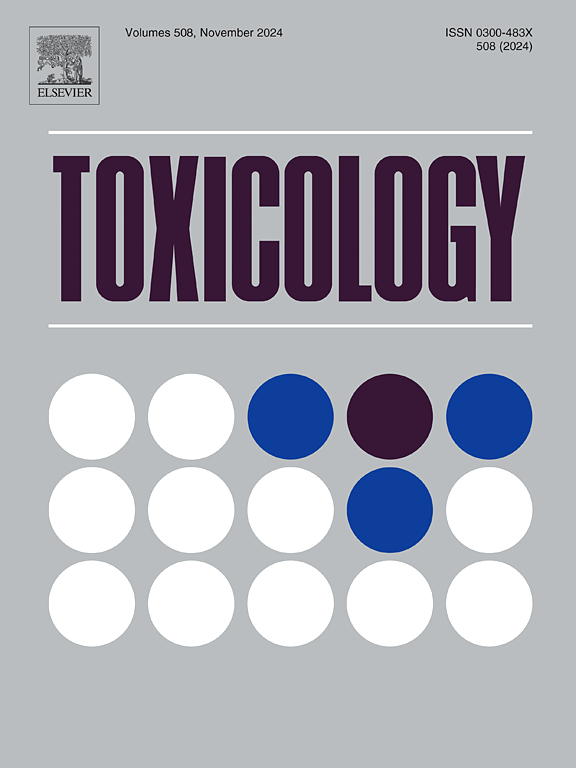Hexafluoropropylene oxide homologues, the novel alternatives to PFOA, induce mitochondrial dysfunction and cytotoxicity in Leydig cells through disrupting SIRT1/PGC-1α signaling pathway
IF 4.6
3区 医学
Q1 PHARMACOLOGY & PHARMACY
引用次数: 0
Abstract
Hexafluoropropylene oxide (HFPO) homologues (HFPOs), specifically HFPO-dimeric acid (DA), HFPO-trimeric acid (TA) and HFPO-tetrameric acid (TeA), have emerged as industrial replacements for phased-out perfluorooctanoic acid (PFOA), garnering considerable attention due to their environmental ubiquity and bioaccumulation potential. Nevertheless, the reproductive toxicity of HFPOs remains incompletely characterized, particularly regarding their endocrine-disrupting effect and the underlying mechanisms involving Leydig cell dysfunction. In this study, we investigated the cytotoxic influences of HFPOs on TM3 Leydig cells, focusing on mitochondrial function and dynamics, oxidative stress, and apoptosis. Our findings demonstrated that exposure to HFPOs significantly compromised mitochondrial function and fusion-fission dynamics by disrupting the SIRT1/PGC1α signaling pathway. The mitochondrial dysfunction further triggered excessive ROS production and apoptosis, ultimately impairing TM3 Leydig cell viability and testosterone secretion. However, supplementation with the SIRT1 agonist SRT1720 relieved the inhibitory effect of HFPOs on SIRT1/PGC1α signaling pathway and reversed the expression of apoptosis-associated proteins (BAX/BCL2), oxidative stress-associated proteins (SOD1/SOD2), as well as proteins associated with mitochondrial fusion (MFN2/OPA1) and fission (DRP1/FIS1). These results elucidated the involvement of the SIRT1/PGC1α pathway in mediating the cytotoxicity of HFPOs. Notably, the activation of SIRT1 mitigated HFPO-induced toxicity in the TM3 cells, highlighting its potential in safeguarding testicular cells from the damage caused by HFPOs exposure.
六氟环氧丙烷同源物,PFOA的新替代品,通过破坏SIRT1/PGC-1α信号通路诱导间质细胞线粒体功能障碍和细胞毒性。
六氟环氧丙烷(HFPO)同系物(HFPOs),特别是HFPO-二聚酸(DA), HFPO-三聚酸(TA)和HFPO-四聚酸(TeA),已经成为逐步淘汰的全氟辛酸(PFOA)的工业替代品,由于其在环境中的普遍存在和生物蓄积潜力,引起了相当大的关注。然而,HFPOs的生殖毒性仍未完全确定,特别是关于其内分泌干扰作用和涉及间质细胞功能障碍的潜在机制。在这项研究中,我们研究了HFPOs对TM3间质细胞的细胞毒性影响,重点是线粒体功能和动力学、氧化应激和凋亡。我们的研究结果表明,暴露于HFPOs通过破坏SIRT1/PGC1α信号通路显著损害线粒体功能和融合裂变动力学。线粒体功能障碍进一步引发ROS过量产生和细胞凋亡,最终损害TM3间质细胞活力和睾酮分泌。然而,补充SIRT1激动剂SRT1720减轻了HFPOs对SIRT1/PGC1α信号通路的抑制作用,并逆转了凋亡相关蛋白(BAX/BCL2)、氧化应激相关蛋白(SOD1/SOD2)以及线粒体融合相关蛋白(MFN2/OPA1)和裂变相关蛋白(DRP1/FIS1)的表达。这些结果阐明了SIRT1/PGC1α通路参与介导HFPOs的细胞毒性。值得注意的是,SIRT1的激活减轻了hfpo诱导的TM3细胞毒性,揭示了其保护睾丸细胞免受HFPOs暴露引起的损伤的潜力。
本文章由计算机程序翻译,如有差异,请以英文原文为准。
求助全文
约1分钟内获得全文
求助全文
来源期刊

Toxicology
医学-毒理学
CiteScore
7.80
自引率
4.40%
发文量
222
审稿时长
23 days
期刊介绍:
Toxicology is an international, peer-reviewed journal that publishes only the highest quality original scientific research and critical reviews describing hypothesis-based investigations into mechanisms of toxicity associated with exposures to xenobiotic chemicals, particularly as it relates to human health. In this respect "mechanisms" is defined on both the macro (e.g. physiological, biological, kinetic, species, sex, etc.) and molecular (genomic, transcriptomic, metabolic, etc.) scale. Emphasis is placed on findings that identify novel hazards and that can be extrapolated to exposures and mechanisms that are relevant to estimating human risk. Toxicology also publishes brief communications, personal commentaries and opinion articles, as well as concise expert reviews on contemporary topics. All research and review articles published in Toxicology are subject to rigorous peer review. Authors are asked to contact the Editor-in-Chief prior to submitting review articles or commentaries for consideration for publication in Toxicology.
 求助内容:
求助内容: 应助结果提醒方式:
应助结果提醒方式:


